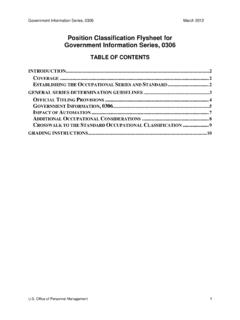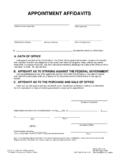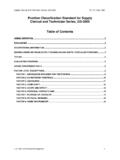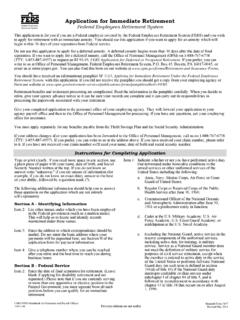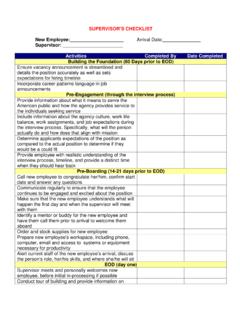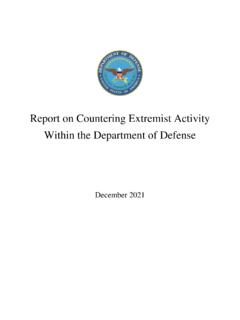Transcription of General Schedule Supervisory Guide - OPM.gov
1 General Schedule Supervisory Guide HRCD-5 June 1998, April 1998 General Schedule Supervisory Guide Table of Contents STATEMENT OF SERIES TITLING INSTRUCTIONS FOR DEPUTY AND "ASSISTANT CHIEF" Supervisory GRADE EVALUATION FACTOR 1 - PROGRAM SCOPE AND FACTOR 2 - ORGANIZATIONAL FACTOR 3 - Supervisory AND MANAGERIAL AUTHORITY FACTOR 4 - PERSONAL FACTOR 5 - DIFFICULTY OF TYPICAL WORK FACTOR 6 - OTHER DETERMINING THE POINT-TO-GRADE CONVERSION Office of personnel management 1 General Schedule Supervisory Guide HRCD-5 June 1998.
2 April 1998 INTRODUCTION This Guide provides evaluation criteria for determining the General Schedule (GS or GM) grade level of Supervisory positions in grades GS-5 through GS-15. It also contains criteria for evaluating managerial responsibilities that may accompany Supervisory responsibilities in this range of grades. However, the Guide is not appropriate for evaluating managerial positions that do not include the accomplishment of work through the supervision of others or that do not require technical competence related to the work directed.
3 This Guide employs a factor-point evaluation method that assesses: - Program Scope and Effect - Organizational Setting - Supervisory and Managerial Authority Exercised - Personal Contacts - Difficulty of Typical Work Directed - Other Conditions General classification concepts, principles, and policies, such as those in the Introduction to the Position Classification Standards, apply to the classification of Supervisory positions. This Guide supersedes the General Schedule Supervisory Guide (GSSG), issued in April 1993, TS-123.
4 STATEMENT OF COVERAGE Use this Guide to grade GS/GM Supervisory work and related managerial responsibilities that: - require accomplishment of work through combined technical and administrative direction of others; and - constitute a major duty occupying at least 25 percent of the position's time; and - meet at least the lowest level of Factor 3 in this Guide , based on supervising Federal civilian employees, Federal military or uniformed service employees, volunteers, or other noncontractor personnel . (Work performed by contractors is considered in applying the grading criteria within each factor of this Guide , provided the position first meets the coverage requirements above based on supervision of noncontractor personnel .)
5 Office of personnel management 2 General Schedule Supervisory Guide HRCD-5 June 1998, April 1998 EXCLUSIONS The following kinds of positions are excluded from the coverage of this Guide : 1. Positions with less than the minimum Supervisory authority described at Level 3-2 of Factor 3 in this Guide . The work of such positions ( , leaders over one-grade interval clerical or technical work or two-grade interval administrative or professional work) is graded through reference to other guides or standards, such as the General Schedule Leader Grade-Evaluation Guide .
6 2. Supervisory positions that have, as their paramount requirement, experience in and knowledge of trades and crafts to perform their primary duties. Such positions are covered by the Federal Wage System (FWS), and are evaluated by application of the FWS Job Grading Standard for Supervisors. NOTE: A Supervisory position over FWS employees, including some at production, maintenance, and overhaul facilities, may be properly classified to a GS series if its primary Supervisory duties do not require experience in, and knowledge of, trades and crafts.
7 3. Positions with project or program management responsibility ( , matrix management , financial management , or team leader duties) that do not directly supervise the work of a recognizable work force on a regular and recurring basis. Evaluate such positions through reference to appropriate standards for the occupation involved or guides such as the Equipment Development Grade Evaluation Guide . (Similar positions with continuing Supervisory responsibilities that meet the minimum requirements for coverage by this Guide may be graded using this Guide provided due care is taken to avoid crediting direction of the same work to supervisors in different chains of command.)
8 4. Positions with oversight responsibilities over only the work of private sector contractors. Evaluate such positions using the appropriate nonsupervisory standards or guides for the occupations involved. 5. Positions in which Supervisory work is carried out only in the absence of another employee or is temporary, short term, and nonrecurring. 6. Positions requiring management skills alone, that is, positions which do not require either technical supervision of employees in specific occupations or competence in a specialized subject matter or functional area.
9 Office of personnel management 3 General Schedule Supervisory Guide HRCD-5 June 1998, April 1998 SERIES DETERMINATION Positions graded by this Guide will continue to be classified in the most appropriate occupational series in accordance with instructions in OPM's Introduction to the Position Classification Standards, occupational definitions in the Handbook of Occupational Groups and Families, and amplifying material in published classification standards. DEFINITIONS The following definitions are included solely for the purpose of applying the criteria in this Guide .
10 For ease of use they are grouped into two sections: Organizational Definitions and Other Definitions. ORGANIZATIONAL DEFINITIONS AGENCY - An executive or military department as specified by 5 101, 102, and 5102, which has primary authority and responsibility for the administration of substantive national programs enacted by Congress; a comparable independent agency; or a large agency next below the Department of Defense with worldwide missions and field activities, multibillion dollar programs or resources to manage, and major mission(s) directly affecting the national security.
